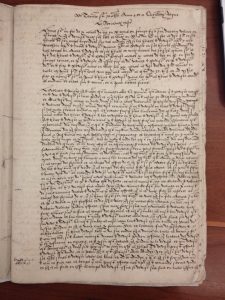
The invention of the printing press revolutionised law reporting. Medieval lawyers had relied less on written texts than on their profession’s ‘common learning’, which was passed down orally at the Inns of Court. Students learnt by observing the courts at work, but also by listening to senior lawyers discussing the law at moots or even over dinner. They rarely cited specific case reports in court, instead referring vaguely to ‘our books’. More precise references would have been unhelpful – after all, manuscript law reports were difficult to access and not necessarily consistent. The appearance of reliable and widely-distributed printed reports encouraged lawyers to cite cases much more extensively.
In the sixteenth century, though, the printed reports available were often decades out of date. Lawyers therefore relied on circulating manuscript case reports to keep on top of new material, and to glean information that the printed reports didn’t provide. We can get an insight into how these cases were shared between lawyers by looking at a manuscript report of the 1567 ‘serjeants’ case’. Serjeants were an elite rank of barristers with special privileges. When a new batch of serjeants was appointed, there would be celebratory feasts and amusements, including a serjeants’ case: a hypothetical case invented for the new serjeants to debate. (Imagine newly-appointed QCs taking part in a moot for their colleagues’ entertainment.)
Like many moot problems today, the serjeants’ case of 1567 was based on a real contemporary case. It concerned the intricacies of will-making. For example, if a testator made a will of ‘all his land’, but acquired new land after making the will, would the new land pass by the previous will? Questions like this were very controversial. Wills of land were new to the common law – they had only been permitted by the 1540 Statute of Wills – so lawyers were still unsure exactly how they should work. The serjeants’ case would have been watched with interest to see what these top barristers thought about the problem – perhaps it would give some clues about what would happen when the real case was argued the following year.

